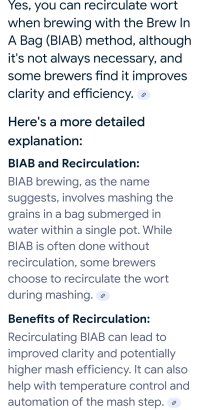shoengine
Whale Noun Member
Rotating racking tube and recirculation\whirlpool arm. Since I am converting to electric I also have an element and a false bottom. If I had bought new I would also get one with a tangential inlet instead of the whirlpool arm.What do you have on your pot?
Be careful with this plan, as it is extremely easy to 1. Over-shoot your temperatures, and 2. Have significant temperature differentials in your mash. Another problem is that conduction works much better than radiation so the sides of the kettle will heat up faster than the mash and then continue to radiate heat into your mash after you turn the burner off. You have to essentially be constantly stirring and turn the propane off before you hit your required temperature.I do have method of heat control, it's a propane burner and you're very correct with insulation (not so accurate with electric ). Temp will be monitored in pot via wifi temp guage. I'll explain:
Extract brewing involves steeping "grain in a bag" at 152f-160f for about 30 mins & I'll cover the lid to maintain temp, stir every 10-15 mins. When temp gets near below temp, i'll just ignite burner to maintain heat.
I tried this early on in my all grain BIAB adventures but moved to insulating instead.
Mechanically it is the same. However with extract brewing you steep the grains for color and flavor while with BIAB you are "steeping" for color, flavor, acidification of the mash and saccharification of the starches contained in the malt.BIAB has the same theory (IMO) as "steeping grain in a bag" as extract, right?
Except, I'm steeping in a much larger bag at a longer time.
Recirculation should help protect against stratification. Not sure it is as effective as stirring, but interested to see. Move your probe around during the mash to ensure it is consistently heated.With a propane burner, heat will be controlled, without electric automated controls, & recirculation will be monitored, accordingly.
Last edited:















































![Craft A Brew - Safale BE-256 Yeast - Fermentis - Belgian Ale Dry Yeast - For Belgian & Strong Ales - Ingredients for Home Brewing - Beer Making Supplies - [3 Pack]](https://m.media-amazon.com/images/I/51bcKEwQmWL._SL500_.jpg)











